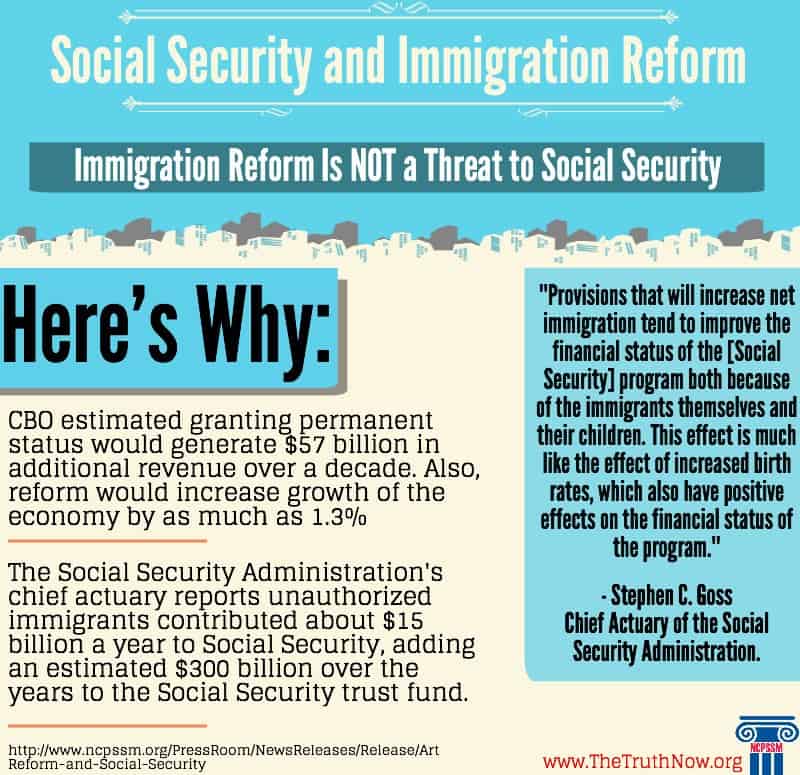 We were glad to join the National Council on Aging and the National Hispanic Council on Aging in a call today briefing reporters on what immigration reform will mean for programs like Social Security. We also released our new analysis today, “Immigration Reform and Social Security” which details why, contrary to claims made by immigration reform opponents, reform is not a threat to Social Security’s funding.
We were glad to join the National Council on Aging and the National Hispanic Council on Aging in a call today briefing reporters on what immigration reform will mean for programs like Social Security. We also released our new analysis today, “Immigration Reform and Social Security” which details why, contrary to claims made by immigration reform opponents, reform is not a threat to Social Security’s funding.
“Those opposed to immigration reform have attempted to use vital programs, like Social Security, as an economic excuse to avoid doing the right thing. The truth is, comprehensive immigration reform is not a threat to Social Security. In fact, earlier immigration reform proposals moderately strengthened Social Security’s financing, and the legislation under consideration today should do the same. By bringing undocumented workers out of the shadows of our economy and into its mainstream, immigration reform has the potential to strengthen Social Security and accelerate overall economic growth.” …Max Richtman, NCPSSM President/CEO
The National Council on Aging and the National Hispanic Council on Aging have also examined immigration reform’s impact on vital programs in their policy brief, “Immigration Reform: Key Issues for Older Adults and People with Disabilities.”
“Comprehensive immigration reform will help millions come out of the shadows. Many of the half million older adult immigrants have worked for decades and contributed millions to Social Security. They should be able to receive the payments they’ve earned. Hispanic seniors, immigrant or not, struggle to reach economic security and without Social Security 50% would live in poverty. Social Security is particularly important to them and instead of denying earned Social Security benefits to new Americans, we should reward their contributions to the United States.” …Jason Coates, NHCOA Public Policy Associate
The NCOA/NHCOA joint study highlighted several important findings, including: immigration reform will increase the number of workers contributing taxes adding additional federal and state revenue, the future ratio of workers to beneficiaries for Social Security and Medicare will be enhanced by the addition of children and grandchildren of immigrants, and the strengthening of a stable direct care work force will assist individuals with disabilities, older adults, and informal family caregivers and also allow newly legalized workers to contribute economically. U.S. businesses lose up to an estimated $33.6 billion per year in lost productivity from full time working informal family caregivers.
“Immigration reform is the right thing to do and the smart thing to do. The practical matter is the number of older people who will need long-term care as they age will double in the coming decade. One in five of our current direct care workforce was born abroad. An estimated 27 million seniors will need long term help by 2050 and the need for direct care workers will grow dramatically, an estimated 1.6 million workers by 2020 and 3 million workers by 2050. Finding a way to provide a stable and steady workforce is crucial.”… James Firman, NCOA President/CEO
Here are some highlights from our report that opponents of immigration reform will never tell you:
- Stephen C. Goss, the chief actuary of the Social Security Administration, has reported that unauthorized immigrants contributed about $15 billion a year to Social Security, adding an estimated $300 billion over the years to the Social Security trust fund. During the most recent attempt to reform our immigration system in 2007, the Congressional Budget Office (CBO) estimated granting permanent status would generate $57 billion in additional revenue over a decade,
- As legal status is granted to current undocumented immigrants, allowing workers to step out of the shadows, contributions to the Social Security program will increase. The CBO estimated that reform would increase the growth of the economy by as much as 1.3 percent.
- Social Security trustees project that an increase in immigration of 100,000 persons a year would improve the long-term actuarial balance of the Social Security’s trust fund by about 3.5% of the projected 75-year deficit.
- The immigrant population, in particular undocumented workers, is very young. In fact 59% are between 25 and 44 years of age. History has shown that their children, as legal second- generation Americans, would make measureable contributions to our nation and economy. A Pew research study of the 20 million adult U.S.-born children of immigrants shows that these adult children have median incomes and homeownership rates similar to the general U.S. population. In fact, second generation adult children of immigrants have a lower poverty rate and higher college graduation rates. All of these demographic factors are potentially good – not bad – news for Social Security.



